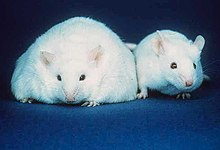User:2607:F140:400:A004:F8A6:A5D4:9D7B:F90F/sandbox
Model Species[edit]
Mice[edit]

Mice are used by scientists as diet-induced obesity models in experiments because they have mammalian physiological systems similar to those in humans. They also can be bred or genetically engineered to be resistant to certain diseases, which can be important for studies of these diseases and/or their influence on other biological systems.[2]
Scientists used mice to study the effect of lymphotoxins on metabolism. Mice without lymphotoxin alpha, lymphotoxin beta, or a lymphotoxin beta receptor had poorly composed microbiota, which made them resistant to obesity. Mice without lymphotoxin alpha, lymphotoxin beta, or a lymphotoxin beta receptor gained less weight on a high-fat diet than wild type mice did, even after remaining on a high-fat diet for a prolonged period of time.[3]Mice are used to study the significance of certain chemicals on obesity. For example, mice were put on a high-fat diet, but given either tap water, green tea, or Goishi tea to drink. The mice who drank Goishi tea gained less weight and had less sugar in their blood than the mice who drank tap water and green tea. The researchers found that Goishi tea prevented the growth of adipocytes and prevented changes caused by tumor necrosis factor alpha and interleukin 6 when the mice were on a high fat diet.[4]Another chemical studied to find an effect on obesity was propolis. To study the effects of the fungus, scientists injected it into mice while they were on an unrestricted high-fat diet. The researchers found that the mice injected with propolis had less adipose tissue, glucose, and cholesterol than the mice who were not administered propolis. Similar effects were seen in mice who were slowly introduced to propolis while on the high-fat diet.[5] Some species of mice are used in research because they have specific traits important for a study rather than for similarity to humans. For example, Apodemus chevrieri is used in studies of metabolism because the length of the day determines their metabolism instead of their diet. In studies with A. chevrieri, scientists found that even if metabolism is controlled by day length, the mice could still gain weight with a high-fat diet.[6]
- ^ en.wikipedia, The original uploader was Bigplankton at English Wikipedia Later versions were uploaded by Sunholm at (2000-01-01), Two mice; the mouse on the left has more fat stores than the mouse on the right., retrieved 2016-11-15
- ^ Spencer, Geoff. "Background on Mouse as a Model Organism". Genome.gov. National Human Genome Research Institute. Retrieved November 13, 2016.
- ^ "Lymphotoxin regulates commensal responses to enable diet-induced obesity". Nature Immunology. 13 (10): 947–953. 26 August 2012. Retrieved 7 November 2016.
- ^ "Effects of Goishi tea on diet-induced obesity in mice". Food Research International. 54 (1): 324–329. November 2013. Retrieved November 7, 2016.
- ^ "Propolis Prevents Diet-Induced Hyperlipidemia and Mitigates Weight Gain in Diet-Induced Obesity in Mice". Biological and Pharmaceutical Bulletin. 32 (12): 2022–2028. December 2009. Retrieved November 7, 2016.
- ^ "Diet induced obesity in Apodemus chevrieri". Italian Journal of Zoology. 81 (2): 235–245. 27 May 2014. Retrieved November 7, 2016.
